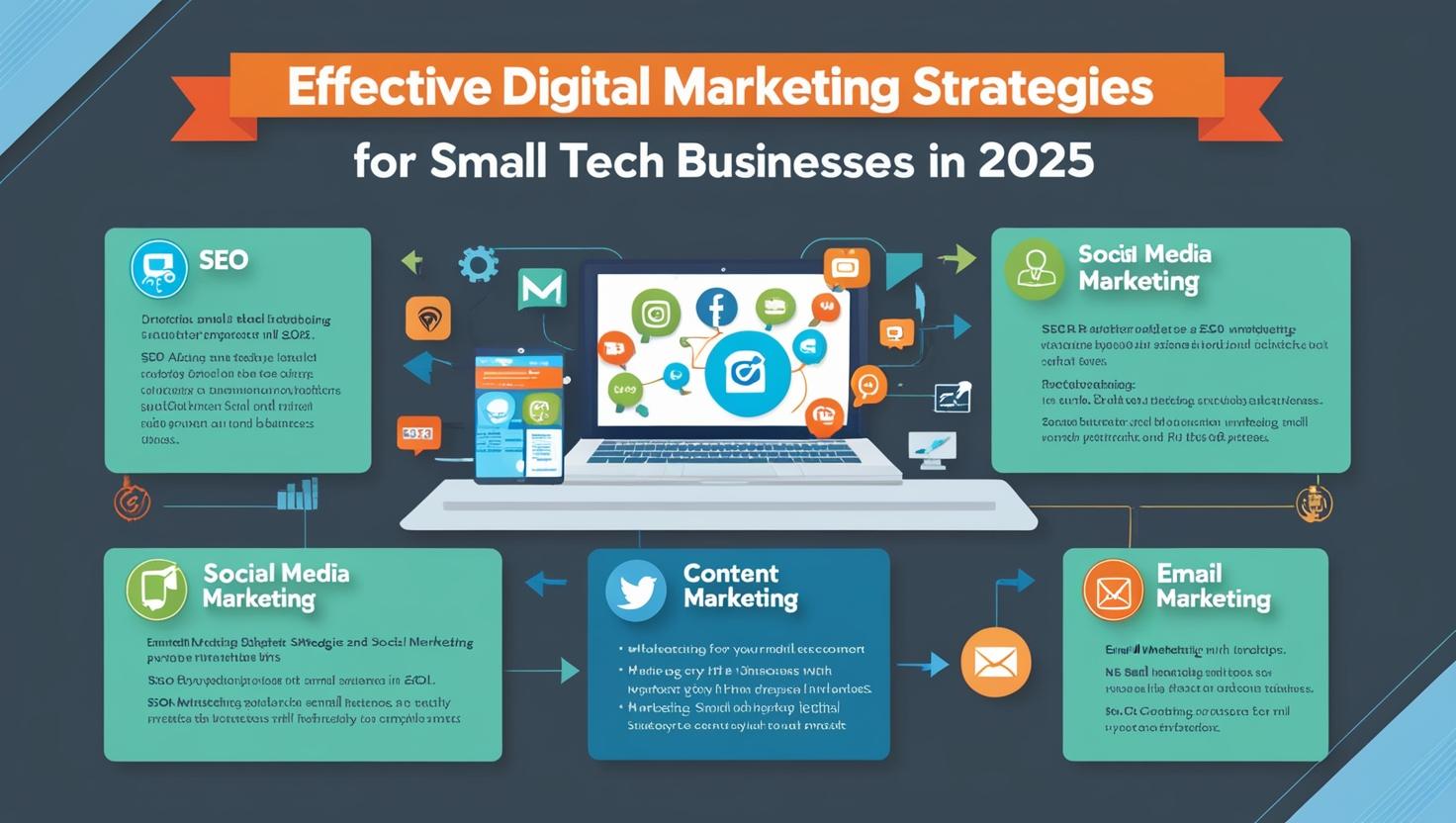Introduction :
In 2025, digital marketing isn’t just optional for small tech businesses—it’s the battleground where brands win or lose. The rapid growth of AI tools, voice search, and consumer expectations means your strategy needs to be smart, scalable, and deeply personalized. This article outlines actionable Digital Marketing Strategies for Small Tech Businesses in 2025, covering everything from AI-powered tools to mobile-first design, content marketing, and much more.
To make your mark in a competitive digital landscape, it’s important to personalize your approach, leverage emerging technologies, and deliver value-driven experiences for your audience.
1. Leverage AI to Automate Your Marketing—But Don’t Forget the Human Touch
AI is transforming digital marketing, enabling small businesses to streamline operations, improve targeting, and optimize campaigns. However, the key to success lies in using AI as a tool, not a crutch.
How AI Helps Small Tech Businesses:
-
Writing drafts: AI tools like Jasper AI can generate blog posts, social media updates, or email drafts, saving time. But always personalize the content to match your brand’s unique voice.
-
Customer behavior analysis: Use tools like HubSpot’s AI to track user interactions and tailor your marketing strategies accordingly.
-
Sales predictions: Leverage predictive analytics tools to forecast which leads are most likely to convert, allowing you to prioritize high-potential prospects.
Real-World Example:
Must Have Ideas, a small UK-based eCommerce brand, leveraged AI to create an automated shopping experience through TV and social platforms—boosting conversions and lowering ad spend significantly.
Why It Matters
-
Saves time by automating repetitive marketing tasks
-
Enables hyper-personalized outreach at scale
-
Makes small teams function like big ones
2. Dominate Your Niche with Long-Tail Keywords
As search engine algorithms become smarter, focusing on broad keywords like “digital marketing” can be a losing battle. Instead, long-tail keywords—specific, buyer-focused phrases—are more effective for driving targeted traffic. These Digital Marketing Strategies for Small Tech Businesses in 2025 are all about niche targeting.
How to Find Long-Tail Keywords: Use tools like Google Keyword Planner, Ubersuggest, or Moz to find specific phrases that align with your business and resonate with potential customers. For example:
-
“Best CRM for small SaaS startups”
-
“Affordable marketing platforms for tech teams”
-
“Top AI tools for digital marketing in 2025”
Why Long-Tail Keywords Work: Long-tail keywords bring in users with clear intent, which leads to higher conversion rates. These users are often closer to making a purchase or decision.
Actionable Tip: Integrate long-tail keywords into your website copy, blog posts, and landing pages to drive more relevant traffic and enhance SEO rankings.
3. Create a Seamless Omnichannel Marketing Strategy
Customers today interact with brands across multiple platforms—from Instagram and LinkedIn to YouTube and TikTok. A strong omnichannel presence is essential to meet customers wherever they are. This is one of the most important Digital Marketing Strategies for Small Tech Businesses in 2025.
How to Build an Omnichannel Strategy:
-
Platform selection: Choose platforms where your audience spends time. Tech businesses typically see good results on LinkedIn for B2B marketing and Instagram/TikTok for consumer-facing brands.
-
Consistent branding: Ensure your brand’s look, feel, and messaging are consistent across all channels.
-
Tailor your message: Each platform requires a unique approach—use professional content for LinkedIn and behind-the-scenes videos or reels for Instagram and TikTok.
-
Link back to your website: Include links to your website or landing pages in posts across all platforms to increase conversions.
Case Study: Dollar Shave Club built a successful omnichannel marketing strategy by connecting their YouTube ads, social media, and email marketing to boost customer retention. They experienced a 12% increase in subscription renewals through this cohesive approach.
4. Prioritize Mobile Experience
In 2025, mobile devices will account for over 70% of web traffic, making mobile optimization non-negotiable. For effective Digital Marketing Strategies for Small Tech Businesses in 2025, mobile optimization must be a priority.
How to Optimize for Mobile:
-
Fast-loading pages: Use tools like Google’s Mobile-Friendly Test to ensure your website loads quickly on mobile devices.
-
Responsive design: Your website must automatically adjust to any screen size, whether it’s a phone, tablet, or desktop.
-
Easy navigation: Simplify your website’s navigation to ensure users can easily find what they’re looking for on mobile.
Actionable Tip: Test your website’s performance on various devices and adjust your design for seamless navigation. A smooth mobile experience will improve engagement and decrease bounce rates.
5. Create Content That Educates & Converts
Content marketing remains one of the most effective ways for small businesses to build trust and drive conversions. Your content should solve real problems and add value to your audience’s lives.
Content Ideas:
-
Blog posts: Write articles that answer common questions or challenges your target audience faces.
-
Webinars and case studies: Host webinars or create in-depth case studies to demonstrate your expertise.
-
Explainer videos: Use short, engaging videos to simplify complex ideas for your audience.
Example: HubSpot used educational content like blogs, eBooks, and case studies to grow from a small tech company into an industry leader. Their content strategy led to 72% more inbound leads within the first year.
Actionable Tip: Make sure every piece of content has a clear call to action (CTA), such as “Book a Free Demo” or “Download the Guide,” to guide visitors to take the next step.
6. Master SEO in 2025
SEO is more than just keywords—it’s about content quality, user experience, and engagement metrics. With Google’s RankBrain and other AI-driven algorithms, your website must meet higher standards than ever before. These principles are critical for Digital Marketing Strategies for Small Tech Businesses in 2025.
SEO Best Practices:
-
Focus on content quality: Create in-depth, well-researched content that provides genuine value.
-
Internal linking: Link to other pages on your site to improve site navigation and SEO rankings.
-
Optimized metadata: Craft unique and compelling meta titles and descriptions to increase click-through rates.
Actionable Tip: Regularly audit your website to ensure that content is updated, accurate, and optimized for both users and search engines.
7. Use Email Marketing to Build Real Relationships
Email marketing continues to have one of the highest ROI among digital marketing strategies. But it’s not just about sending regular newsletters—it’s about creating a personalized experience for each subscriber. As part of your Digital Marketing Strategies for Small Tech Businesses in 2025, email remains a powerful tool.
How to Optimize Email Marketing:
-
Segmentation: Group your email list by customer behavior, location, or past purchases to send more personalized offers.
-
Personalized subject lines: Use tools like Phrasee to craft email subject lines that increase open rates.
-
Automated campaigns: Use email automation for lead nurturing and post-purchase follow-ups.
Case Study: Litmus, an email marketing company, boosted its email open rates by 55% through segmented email campaigns based on user behavior.
Actionable Tip: Continuously segment and test your email lists to improve engagement and conversion rates.
8. Track, Test & Optimize
Even the best strategies need to be tested and optimized over time. As a small business, you don’t have the luxury of wasting marketing dollars, so data is your best friend. This is part of the overall Digital Marketing Strategies for Small Tech Businesses in 2025 approach.
Key Metrics to Track:
-
Clicks and conversions: Track how many people click on your ads, emails, or website links and how many make purchases.
-
Bounce rates: A high bounce rate may indicate issues with your website’s user experience.
-
Customer engagement: Monitor social media and email engagement to gauge the effectiveness of your content.
Actionable Tip: Use tools like Google Analytics, Hotjar, and HubSpot to gather data and make data-driven decisions to improve your campaigns.
9. Optimize for Voice Search & Short-Form Video
Why It Matters in 2025:
With 50% of searches predicted to be voice-based (Oberlo, 2024) and short-form video dominating engagement (TikTok, Reels, YouTube Shorts), small tech businesses must adapt—or get left behind.
Voice Search Optimization
- Use conversational long-tail keywords:
- Target natural phrases like “Hey Google, what’s the easiest CRM for a startup?” instead of stiff, typed queries.
- Tools like AnswerThePublic or SEMrush’s “Voice Search Keyword” feature can help identify these.
- FAQ schema markup: Add structured data to your website so voice assistants can pull answers directly from your content.
Short-Form Video Tactics
- Repurpose blogs into 15-60 second clips:
- Example: Turn a “Top 5 AI Tools” blog into a TikTok slideshow with a CTA like “DM us for the full guide!”
- Behind-the-scenes (BTS) content: Show your tech team’s workflow or product development to humanize your brand.
- Trend-jacking: Leverage trending sounds/challenges (e.g., “POV: Your CRM finally just works”) to boost discoverability.
Pro Tip: Use AI tools like OpusClip to auto-generate short videos from long-form content.
Conclusion: Go Deep, Not Wide
In 2025, small tech businesses can outperform larger competitors by focusing on efficiency, personalization, and speed. By applying these Digital Marketing Strategies for Small Tech Businesses in 2025, you’ll be able to create more authentic and targeted campaigns, build stronger customer relationships, and ultimately drive more growth.
Are you ready to implement these strategies in your business? The time to act is now—optimize, automate, and adapt to ensure your success in the ever-evolving world of digital marketing.


